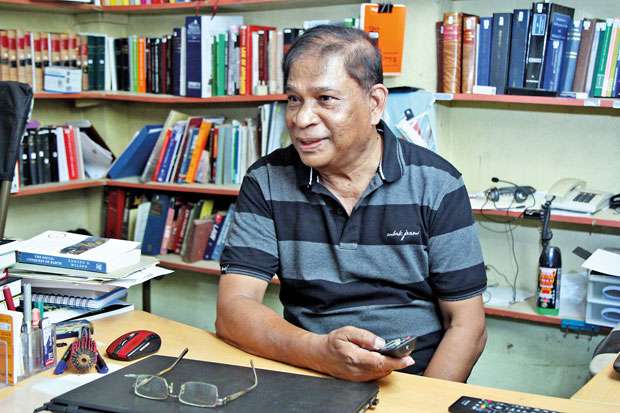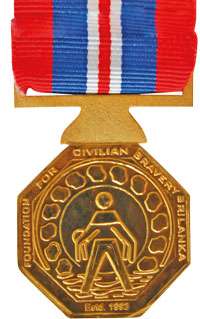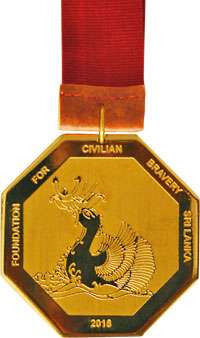Reply To:
Name - Reply Comment
 Kasun Chandraratne
Kasun Chandraratne
Pic by Damith Wickramasinghe

It takes a lot of courage to risk your own life and save another’s life. It becomes an honourable act when you don’t expect anything in return. There have been stories of kings and other locals whom we have referred to as heroes but the actual heroes are behind the scenes. Identifying the need to recognise such individuals, Kasun Chandraratne had a vision to bring them to the limelight. Hence, the Foundation for Civilian Bravery was born 24 years ago.
“I was quite fond of the language in the Reader’s Digest and used to buy it regularly,” recalled Chandraratne in an interview with Mirror of Hope. “In one of them I read about a girl in India who had saved her father’s life and was recognized for Civilian Bravery by the Carnegie Hero Fund Commission. Then this idea dawned in me and I thought I should start something similar in Sri Lanka.
I never had an idea to start a foundation but I drafted a law titled President’s Trust for Civilian Bravery during Premadasa’s tenure. But then I was constantly asked whether there were such people and if so, how to find them. Although I didn’t know how, I was adamant to move ahead with this concept and the Foundation for Civilian Bravery was born 24 years ago. So far we have succeeded in acknowledging the attempts made by people to save another person’s life.”
Women are the most suitable people for bravery but their stories are unheard of. This year we received close to 200 applications but I am sure there are more incidents of people who have committed their time and risked their lives for the sake of another human being...
Back in the day national heroes were kings or affluent people in society. “This could be because we are a traditional society,” he added. “The value is attached to the position and title a person holds. The maiden activity was when a 74-year old ferryman in Ukwatte, Kalutara risked his life to save six passengers when his ferry capsized and he passed away while saving the sixth.
I have come across stories of coconut pluckers saving another plucker’s life when the latter’s shoulder dislocated while he was at the top of the tree, a cleaner in Kandy rescuing two children from a house on fire and so on. Therefore, we do have stories and I’m sure there are many people who have risked their lives to save another’s life and have never been acknowledged. We eventually grew and if we look at other countries such as Australia and America, civilian bravery has been around for over 100 years. But Sri Lanka has a history of over 2500 years and we have heard lesser stories of civilian bravery.”
This year a students’ category was introduced to give an opportunity to them as well. “They can’t risk their lives but it is important to give them the direction of bravery,”
 Speaking further Chandraratne said that the term ‘civilian bravery’ has no definition. “But we introduced three criteria that an applicant or nominee should fulfil. If I sum it up in a sentence, the award is given to a person who voluntarily saves another person who is in peril. The design of the medal depicts a person saving a being, which could be either a person or an animal with floods and fire in the background and the octagonal shape indicates the eight directions.
Speaking further Chandraratne said that the term ‘civilian bravery’ has no definition. “But we introduced three criteria that an applicant or nominee should fulfil. If I sum it up in a sentence, the award is given to a person who voluntarily saves another person who is in peril. The design of the medal depicts a person saving a being, which could be either a person or an animal with floods and fire in the background and the octagonal shape indicates the eight directions.
This year’s winner is a CTB bus driver in Haputale who was driving down a slope in a bus with faulty breaks. There had been 22 people in the bus and when he realized the fault he had asked the passengers to shift to the other side. He had driven against the hill and while saving the lives of the 22 people, three others were killed in the accident including him. Therefore such people should be recognized for their bravery. The National Civilian Bravery Awards Night is an annual event where we have been recognising these people since its inception.”
This year a students’ category was introduced to give an opportunity to them as well. “They can’t risk their lives but it is important to give them the direction of bravery,” Chandraratne continued. “Therefore a student who is a member of a social service organization who dedicates his or her time for the cause is eligible to apply under this category. Here we introduce the concept of ‘biophyllic’ which translates to ‘jaivahithakami’ in Sinhala and bravery is something that is linked with biology. Therefore we are encouraging students to do social service and show them that they can commit bravery since they love living beings.”
Chandraratne encourages more applicants to apply and let their voices be heard.
“I’m very keen to encourage people in the North and East to apply. There have been few cases but I’m sure there are many more.
Also if we really look at it, women are the most suitable people for bravery but their stories are unheard of. This year we received close to 200 applications but I am sure there are more incidents of people who have committed their time and risked their lives for the sake of another human being or an animal, that we just don’t know about.”
Referring to the book titled ‘The Social Conquest of Earth’ by Edward O. Wilson, Chandraratne related how humans have worked in groups for survival from the hunter-gatherer days. “In other words, altruism is something that we all have.
In research conducted by Wilson he says that ants and bees have societies with agriculture and other elements. They are similar to humans in a lot of ways. Therefore there’s altruism in all of us, at least as a suppressed trait. Another observation we can take from the animal kingdom is that of the monkey that spots a tiger. He climbs up the tree and alarms other animals. As such it fits all the criteria we have emphasized; the monkey risks its own life voluntarily to save the rest of the animals. This is also seen in birds when a snake approaches a nest. Therefore it’s in the genes of animals, but as a society it’s limited since we have more selfish traits. We need to be humble and appreciate people in all levels of society. Until that happens, society will never change.”
This wonderful organisation isn’t Government funded and Kasun has poured his heart and soul into it to make sure that “if you save and serve, you will be recognised.”
If you know of a brave soul who has risked his or her life to save another’s or if you want to contribute to this cause contact the Foundation on +94 38 224 1777 or drop an email to [email protected]
 1993 Seneris, a ferryman aged 74, saved 5 mothers on board when a ferry capsized in the middle of the river but in his attempt to save the sixth, he died with her.
1993 Seneris, a ferryman aged 74, saved 5 mothers on board when a ferry capsized in the middle of the river but in his attempt to save the sixth, he died with her.
1996 Trevo, a disabled  soldier, on his way home notices some explosives on board the train. The train was packed with home bound passengers after office. He removed the terrorist bomb amidst protests from civilians.
soldier, on his way home notices some explosives on board the train. The train was packed with home bound passengers after office. He removed the terrorist bomb amidst protests from civilians.
1999 Nandasena rescued a Coconut plucker who was trapped  up on a coconut tree due to dislocation of his shoulder as he was climbing up to pluck coconuts
up on a coconut tree due to dislocation of his shoulder as he was climbing up to pluck coconuts
2003 Channa , a teacher noticing a child falling into a waste pit which was on fire, jumped into the pit to rescue the student. Unfortunately the student who was rescued succumbed to his injuries later. The teacher suffered burn injuries.
, a teacher noticing a child falling into a waste pit which was on fire, jumped into the pit to rescue the student. Unfortunately the student who was rescued succumbed to his injuries later. The teacher suffered burn injuries.
2009 Ajit of Sri Lanka Army learning th at a woman had jumped to the crocodile infested Nilwala River to commit suicide, raced to the bridge and jumped into the water and brought her to safety.
at a woman had jumped to the crocodile infested Nilwala River to commit suicide, raced to the bridge and jumped into the water and brought her to safety.
2018 H. M Keerthi Bandara P admasiri was driving a bus with faulty brakes but managed to save the lives of 22 passengers in the bus. Unfortunately he died in the incident.
admasiri was driving a bus with faulty brakes but managed to save the lives of 22 passengers in the bus. Unfortunately he died in the incident.